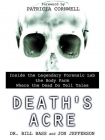Death's Acre: Inside The Legendary Forensic Lab The Body Farm Bill Bass (howl and other poems TXT) 📖

- Author: Bill Bass
Book online «Death's Acre: Inside The Legendary Forensic Lab The Body Farm Bill Bass (howl and other poems TXT) 📖». Author Bill Bass
On Saturday, September 8, I typed up my report and mailed it to the lead KBI agent investigating the case, along with a copy to the KBI’s director in Topeka. Single-spaced, the report didn’t even fill two pages.
In the end, there wasn’t really much I could tell the KBI about her beyond her sex, race, age, stature, and poor dental health. The skull and femur revealed nothing about her manner of death. But apparently the KBI had more to work with than I did, and after my examination and report, they were confident that Mary Louise Downing had indeed been found. From the fact that she’d been hidden in a remote stretch of the river bottoms, they assumed she’d been murdered.
But that was it. Who had killed her, and why, and where, and when—those were secrets that only two people possessed, the killer and Mary Louise, and neither one was talking.
After mailing off the report, I took one more look at her skull. Piercing her cheekbones and lower jaw, about an inch and a half on either side of the skull’s midline, were four neat, tiny holes where the craniofacial nerves had emerged from her brain. Thin bundles of electrochemical fibers, they would have translated this woman’s inner sadness into outward frowns, her purest happiness into the slightly sideways smile that her crossbite would have given her. She had been someone’s daughter, someone’s wife, someone’s mother. Now she was reduced to a case—one that would never be solved.
Her disappearance that day in August hadn’t merited a mention in the local newspaper; the discovery of her body in early September had rated only two column inches. In death, as in life, Mary Louise seemed destined to fall through the cracks, unnoticed, uncared for, insignificant.
And yet . . . And yet . . . We’ve spent forty years together now, Mary Louise and I. She’s been in almost every classroom I’ve set foot in; she’s traveled with me to seminars and conferences, all over the United States: the FBI Academy at Quantico, Virginia; the Bureau of Alcohol, Tobacco and Firearms trainings in half a dozen states; the U.S. Army Central Identification Laboratory in Honolulu, Hawaii. In life Mary Louise probably never traveled far from Atchison or accomplished much that would look noteworthy. But in death she’s journeyed halfway around the world, educated thousands of students, and helped train hundreds of forensic anthropologists, homicide investigators, crime lab technicians, and medical examiners.
Mary Louise’s murder will probably never be solved. But, thanks to her, other murders will be—and probably already have been. To me, that makes her a remarkable woman, and a forensic hero.
No bones about it.
CHAPTER 4
The Unsavory Uncle
ASHERIFF’S DEPUTY appeared in the doorway of my office in the Museum of Natural History at the University of Kansas in Lawrence in December of 1970. Six months later and the deputy wouldn’t have found me in Kansas. I had already accepted a new job at the University of Tennessee in Knoxville, and we planned to move the following May.
The deputy caught me at the desk where I’d spent falls, winters, and springs for the past decade. During that time, the University of Kansas had built one of the best physical-anthropology programs in the nation. With three young, innovative physical anthropologists on the faculty, we were becoming widely known for our forensic expertise. By now I’d worked dozens of forensic cases for various law enforcement agencies, ranging from tiny sheriffs’ offices to the Kansas Bureau of Investigation, whose associate director, Harold Nye, had become a good friend of mine.
Harold was something of a celebrity in law enforcement circles by this time. He played the key role in tracking down the two former convicts who murdered a family of four in west Kansas in 1959. The case—the murder of the Clutter family, and the KBI’s pursuit of their killers—sparked one of the all-time classics of crime writing, Truman Capote’s In Cold Blood, which came out in 1965.
Capote recounted how Nye fought a persistent case of the flu during the six weeks it took to catch the killers, ex-convicts Dick Hickock and Perry Smith. Despite fevers, Harold worked tirelessly as part of the team of four KBI agents assigned to the case. He followed Perry Smith’s trail to a cheap rooming house in Las Vegas where he had stayed shortly before the murders; more important, he learned from the manager that she was expecting Smith to return to claim a box of possessions he’d stored there. In Mexico City—one of many places the killers traveled after the crime—Harold managed to find a pair of binoculars and a transistor radio they’d stolen from the Clutter house and pawned for a few dollars. Those were important pieces of evidence at the trial, because they helped prove the men had been at the house.
Harold also snagged another key piece of evidence at the murder scene itself. Two distinctive sets of boot prints, too faint for the human eye to notice, showed up in Harold’s photos of the Clutters’ basement floor. When the killers were arrested, their boots matched those prints exactly. Thanks to meticulous casework by Harold and the other KBI agents, the two men were convicted of first-degree murder and hanged.
Harold didn’t much like Truman Capote’s account of the case; Nye thought it took too many liberties with facts. He also didn’t think much of Capote himself: When Harold went to Capote’s hotel room to do an interview, Capote answered the door wearing a lacy negligee. That must have given straight-arrow Harold quite a jolt, but he





Comments (0)